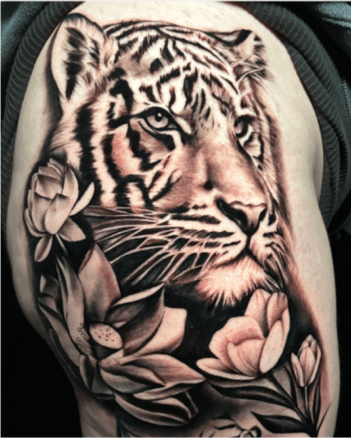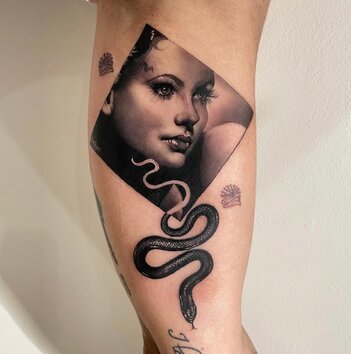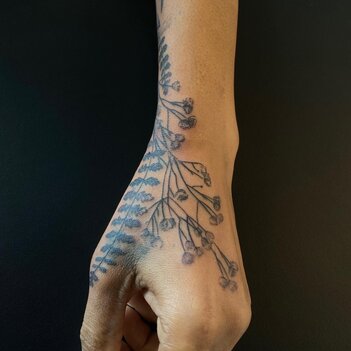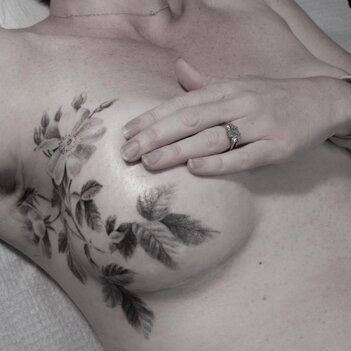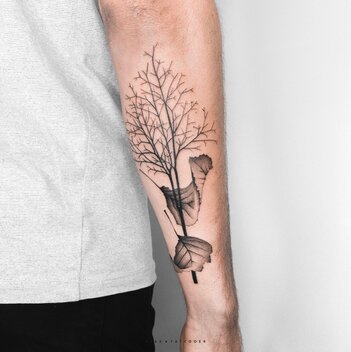In this article, we explore 10 of the most popular tattoo styles, some of the key artists who pioneered and created these styles, and brief historical context. Before we dive in, it is worth noting that tattoos have evolved into an art showcasing a diverse range of styles that reflect personal narratives, cultural influences, and artistic preferences – so creating a definitive list limited to 10 styles was tricky.
1. Traditional Tattoo Style (Old School Style)
The Traditional tattoo style, rooted in naval and maritime history, embraces bold black outlines, a limited color palette, and includes iconic motifs such as swallows, anchors, dragons, ships, snakes, skulls, eagles or panthers. Sailor Jerry, Lyle Tuttle, and Don Ed Hardy belong to the roster of famous names in the Traditional tattoo style.
Traditional tattoos have stood the test of time, connecting modern enthusiasts with the rich history of this art form. It is also noted that the bold lines and limited color palette are good for the tattoos longevity.
2. Realism Tattoo Style
Realism tattoos strive to replicate lifelike images on the skin, capturing intricate details with precision and depth. This style demands a high level of skill from artists who master shading and blending techniques to achieve realism.
Emerging in the late 20th century, this style gained prominence as artists sought to bring photographic accuracy to body art. Pioneers like Robert Hernandez and Paul Booth created hyper-realistic masterpieces that blurred the line between tattooing and traditional art. Their work inspired a wave of talented artists, including Nikko Hurtado, Mike DeVries, Moni Marino, Katrina “Kat Tat” Collins, and Cleo Pétra who continue to elevate Realism tattoos by transforming skin into canvases that mirror the beauty and intricacy of the real world.
3. Watercolor Tattoo Style
A relatively recent trend, Watercolor tattoos burst onto the scene with vibrant, fluid designs reminiscent of watercolor paintings. With a free-flowing and abstract approach, these tattoos incorporate splashes of color, offering a dynamic and visually striking alternative.
Departing from traditional tattoo techniques, artists began experimenting with color gradients, splashes, and brushstroke effects. Key figures in the evolution of Watercolor tattoos include Amanda Wachob, recognized for her innovative approach, and Sasha Unisex, whose use of bright hues and freeform designs propelled the style's popularity. Victor Montaghini applies an interesting touch to typical watercolor tattoos.
4. Japanese (Irezumi) Tattoos
Japanese Irezumi tattoos, rooted in centuries-old tradition, showcase intricate designs inspired by Japanese folklore, mythology, and cultural symbols. Depicting creatures, flowers, and waves, this style demands a skilled artist well-versed in Japanese symbolism and aesthetics.
Originating in the Edo period, this style was initially worn by warriors for protection and identification. Modern Irezumi artists like Horiyoshi III, Shige, and Horimitsu fuse traditional elements with contemporary flair, creating breathtaking pieces that honor the historical significance of the art. Horimitsu and Horiyoshi III's mastery in tebori (hand-poking) and Shige's innovative approach have elevated the global appreciation for Irezumi. Artists including Hiromitsu blend the traditional Japanese style and methods with modern approaches.
5. Neo-Traditional Tattoos
Neotraditional tattoos, a vibrant blend of classic and contemporary, emerged in the late 20th century as a response to the resurgence of traditional styles. Inspired by the bold lines and iconic imagery of Traditional tattoos, neotraditional artists introduced a broader color palette and intricate detailing.
Key figures like Paul Rogers and Sailor Jerry influenced this evolution, paving the way for modern masters such as Adam France. These artists have skillfully merged timeless elements with new-school techniques, creating tattoos that bridge the gap between tradition and innovation, marking neotraditional as a dynamic and influential style in the tattoo world.
6. Geometric Tattoos
Geometric tattoos, a contemporary fusion of precision and artistry, draw inspiration from mathematical shapes and cultural symbols. While this style draws inspiration from tribal tattoos dating back thousands of years, it gained popularity as tattoo artists began experimenting with intricate patterns and clean lines.
Key figures like Dr. Woo, a celebrity favorite, significantly shaped the evolution of geometric tattoos. While artists such as Dillon Forte and Black Symmetry take a different approach in treating the full body as a single canvas for intricate patterns and complex geometry. Today, geometric tattoos continue to captivate with their visually stunning and modern aesthetic, showcasing the harmonious marriage of art and mathematics.
7. Botanical Tattoos
Botanical tattoos celebrate nature's beauty, featuring intricate depictions of flowers, plants, and foliage. The style traces its roots to traditional tattooing, where flowers and natural elements were symbolic.
In contemporary tattooing, artists like Dodie, David Allan, and Alice Carrier have popularized botanical designs, showcasing meticulous linework and shading to capture the essence of flora. Botanical tattoos are revered for their timeless elegance and the ability to convey personal meanings through the language of flowers. This style flourishes as skilled artists continue to interpret and reimagine the rich diversity of the natural world on the canvas of human skin.
8. Illustrative Tattoo Style
Illustrative tattoos, characterized by artistic, stylized designs, have roots in traditional tattooing but gained prominence in the contemporary era. The style emphasizes creativity, often featuring bold lines, vibrant colors, and imaginative subject matter.
Artists like Nomi Chi and Pony Reinhardt have contributed significantly, infusing their illustrative works with storytelling and symbolic elements. Snuffy creates Illustrative tattoos ranging from whimsical, surreal and fantastical to deeply symbolic, providing a broad scope for artistic expression. This style continues to evolve, attracting those who seek personalized and visually captivating tattoos that transcend traditional boundaries.
9. Minimal Tattoo Style
Minimalist tattoos, characterized by simplicity and clean design, came on to the scene as a reaction against elaborate and intricate styles. This contemporary trend draws inspiration from traditional tattooing's straightforward aesthetic. Minimalist tattoos embrace the "less is more" philosophy, offering a modern and subtle expression of personal style on the ever-evolving canvas of body art.
Key artists like JonBoy and Playground Tattoo have popularized minimalism, showcasing tiny yet impactful designs. Curt Montgomery has become a fan favorite with his sassy, sexual, bold, minimal line work. Playground Tattoo, based in Korea, is recognized for their minimalist approach, often incorporating fine lines and subtle shading.
10. Chicano Style Tattoos
The Chicano Style, or Black and Grey tattooing, originating in East LA prisons during the 1970s, initially utilized rudimentary equipment to create monochromatic designs due to limited resources. The style gained prominence as artists sought to elevate it beyond its humble beginnings and honor things such as the Mexican Revolution and Pachuco culture.
Legends like Jack Rudy and Freddy Negrete pioneered the use of fine-line techniques, introducing realism to black and grey tattoos. Artists like Chuey Quintanar and Brian Everett expanded the style's horizons, blending meticulous shading with artistic flair. Today, luminaries like Jun Cha and Carlos Torres continue to push the boundaries.






